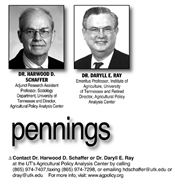|
Over One Third Of 2020 Net Farm Income Is Expected To Be Government Payments

The United States Department of Agriculture’s (USDA) recently released “2020 Farm Sector Income Forecast” (https://tinyurl.com/y8eyglz5) contains good news and bad news.
The good news: 2020 net farm income is forecast to be $102.7 billion, the first time it has been above $100 billion since 2013. The increase from 2019 to 2020F is $19.0 billion.
The bad news: cash receipts from animals, crops, and other farm-related economic activity are forecast to be down by $13.8 billion compared to 2019. In addition, the value of animals and animal products held on the farm declined by $8.5 billion while the value of crops stored almost remained steady with a decline of $0.6 billion.
The value of federal government direct farm program payments (direct payments) increased by $14.7 billion in 2019 to $37.2 billion in 2020F. These direct payments accounted for 36.2 percent of 2020F net farm income compared to 8.9 percent in 2013, the last time net farm income was above $100 billion.
Of the $37.2 billion in 2020F direct payments $4.7 billion will be paid under the Agricultural Risk Coverage (ARC) program, reflecting prices that have fallen below the reference prices that were first set in the 2014 Farm Bill. An additional $0.1 billion will be paid as Price Loss Coverage (PLC) payments. ARC and PLC are the current countercyclical price-based programs.
Loan Deficiency Payments and Marketing Loan Gains for 2020F are expected to total $0.9 billion. In 2019 these payments were concentrated in North Dakota, Montana, Idaho, Washington, and Texas.
Conservation programs including the Conservation Reserve Program are forecast to cost $4.0 billion in 2020.
According to the USDA, “supplemental and ad hoc disaster assistance payments in 2020 are forecast at $23.4 billion … mainly from payments from the Coronavirus Food Assistance Program (CFAP) and the Paycheck Protection Program (PPP).
“The Coronavirus Food Assistance Program (CFAP) provides direct relief to producers who faced price declines and additional marketing costs due to COVID-19. Payments in calendar year 2020 for this USDA program are forecast at $16.0 billion.
“Also included under supplemental and ad hoc disaster assistance are payments from the Paycheck Protection Program (PPP), administered by the Small Business Administration. The payments are designed to help small businesses keep their workers on the payroll during the COVID-19 pandemic. Although administered as a ‘loan,’ the loans will be forgiven if the program’s requirements are met. We treat these loans as a direct payment to farmers and forecast them at $5.8 billion in 2020. This amount may be revised, with any unforgiven amounts ending up as farm debt rather than a direct payment” (https://tinyurl.com/y8eyglz5).
The major last component of direct payments is $3.8 billion for the Market Facilitation Program (MFP). These payments reflect payments that were obligated in 2019 but paid in 2020. The MFP was the program the administration developed to compensate farmers for reduced prices that resulted from the trade dispute with China.
Looking to the next farm bill that is slated for 2022, we think it is reasonable to believe that the $37.2 billion annual cost we see for this year will not be available for legislators to work with in designing the next farm program.
Of more immediate concern is that even with payments of this size, farm debt is forecast to increase by $15.2 billion to $433.8 billion in 2020. As a result, the debt-to-equity ratio increases by 0.46 percent to 16.2 percent and the debt-to-asset ratio increases by 0.34 percent to 14.0 percent. In 2013 the debt-to-equity ratio was 12.9 percent while the debt-to-asset ratio was 11.9 percent. Without a program to raise crop prices, these debt increases will result in an ever-growing number of farm bankruptcies. ∆
DR. HARWOOD D. SCHAFFER: Adjunct Research Assistant Professor, Sociology Department, University of Tennessee and Director, Agricultural Policy Analysis Center
DR. DARYLL E. RAY: Emeritus Professor, Institute of Agriculture, University of Tennessee and Retired Director, Agricultural Policy Analysis Center
|
|